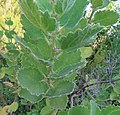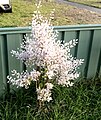
Kniphofia is a genus of perennial flowering plants in the family Asphodelaceae, first described as a genus in 1794. The species are native to Africa. Common names include tritoma, red hot poker, torch lily and poker plant.

The Harry P. Leu Gardens are semi-tropical and tropical gardens in Orlando, Florida, United States. The gardens contain nearly 50 acres (200,000 m2) of landscaped grounds and lakes, with trails shaded by 200-year-old oaks and forests of camellias. They are open to the public. The address is 1920 North Forest Avenue Orlando, FL 32803.

Plectranthus is a genus of about 85 species of flowering plants from the sage family, Lamiaceae, found mostly in southern and tropical Africa and Madagascar. Common names include spur-flower. Plectranthus species are herbaceous perennial plants, rarely annuals or soft-wooded shrubs, sometimes succulent; sometimes with a tuberous base.

Caulophyllum thalictroides, the blue cohosh, a species of Caulophyllum is a flowering plant in the Berberidaceae (barberry) family. It is a medium-tall perennial with blue berry-like fruits and bluish-green foliage. The common name cohosh is probably from an Algonquian word meaning "rough". The Greek-derived genus name Caulophyllum signifies "stem-leaf", while the specific name thalictroides references the similarity between the large highly divided, multiple-compound leaves of meadow-rues and those of blue cohosh.

Eucomis comosa, the pineapple flower, pineapple lily or wine eucomis, is a species of flowering plant in the asparagus family Asparagaceae. A deciduous bulbous perennial used as an ornamental plant, it is endemic to South Africa. The white to purple flowers appear in summer and are arranged in a spike (raceme), topped by a "head" of green leaflike bracts.
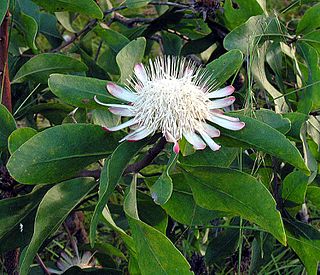
Protea gaguedi is a species of tree which belongs to the genus Protea.

Plumbago auriculata, the Cape leadwort, blue plumbago or Cape plumbago, is a species of flowering plant in the family Plumbaginaceae, native to South Africa and Mozambique.

Aloe marlothii is a large, single-stemmed Southern African aloe of rocky places and open flat country, occasionally growing up to 6 m tall.

Thaumatococcus daniellii, also known as miracle fruit or miracle berry, is a plant species from tropical Africa of the Marantaceae family. It is a large, rhizomatous, flowering herb native to the rainforests of western Africa in Sierra Leone, southeast to Gabon and the Democratic Republic of the Congo. It is also an introduced species in Australia and Singapore.

Horkelia marinensis is a rare species of flowering plant in the rose family known by the common name Point Reyes horkelia. It is endemic to the California coastline, where it is known from about Fort Bragg to near Santa Cruz. It grows on beaches and in other sandy coastal areas. This is a perennial herb growing in low, dense patches. The leaves are up to 10 centimeters long and are made up of toothed, hairy, gray-green leaflets each around a centimeter long. The foliage is glandular and strongly scented. The plant produces green to reddish-green stems up to 30 centimeters long which bear inflorescences of dense clustered flowers. Each flower has minute bractlets under reddish-green, fuzzy sepals. The petals are generally white and narrow with rounded ends. The center of the flower contains a ring of stamens around a patch of 20 to 30 pistils.
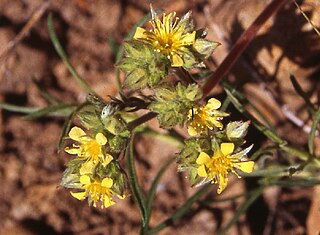
Ivesia aperta is a species of flowering plant in the rose family known by the common name Sierra Valley mousetail.

Dracaena aletriformis is commonly known as the large-leaved dragon tree. These plants are found in forest in the eastern areas of South Africa from Port Elizabeth to northern and eastern Limpopo. They are also found in Eswatini, but are most common in the coastal and dune forests of KwaZulu-Natal.

Crassula capitella, is a perennial succulent plant native to southern Africa.

Crassula ovata, commonly known as jade plant, lucky plant, money plant or money tree, is a succulent plant with small pink or white flowers that is native to the KwaZulu-Natal and Eastern Cape provinces of South Africa, and Mozambique; it is common as a houseplant worldwide. Much of its popularity stems from the low levels of care needed; the jade plant requires little water and can survive in most indoor conditions. It is sometimes referred to as the money tree; however, Pachira aquatica also has this nickname.

Crassula nudicaulis is a succulent plant native to South Africa, and Lesotho.

Coleus neochilus, synonym Plectranthus neochilus, which is colloquially known as lobster bush, fly bush or mosquito bush, is a perennial ground cover with highly fragrant, partially scalloped, ovate leaves and purple blue inflorescent spikes.
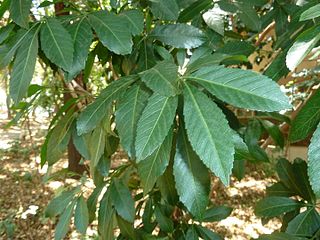
Allophylus natalensis, commonly known as the dune false crowberry or dune false currant, is a species of plant in the genus Allophylus native to south-eastern Africa.

Microcoelia exilis, commonly known as the pinhead orchid, is a species of flowering plant in the orchid family, Orchidaceae. It is a leafless epiphyte, a perennial herb that grows in a tangled cluster of roots and stems on the branch of a tree. This orchid is native to tropical central and eastern Africa and was first described in 1830 by the English botanist John Lindley.
Plectranthus purpuratus or cliff spurflower is a species of flowering plant in the family Lamiaceae, native to South Africa's Kwazulu-Natal and Mpumalanga provinces, as well as eSwatini. The name is frequently misapplied to Plectranthus ciliatus, presumably because both have purple-backed leaves.

Zaluzianskya ovata, the night scented phlox, is a species of flowering plant in the family Scrophulariaceae, native to Lesotho and South Africa.



